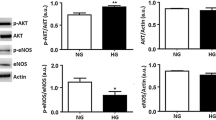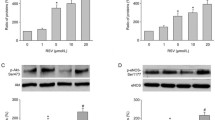Abstract
To investigate the effects of resveratrol on the secretion of NO induced by insulin in high glucose cultured primary human umbilical vein endothelial cells (HUVEC). HUVEC were treated with 1 μmol/l resveratrol for 24 h before cultured in high glucose medium for 48 h, then all cells were stimulated by 100 nmol/l insulin for 30 min. Method based on nitric acid reductase was used to analyze the NO contents in the supernatant. Cells were collected to analyze the expression of eNOS, endothelin-1, E-selectin, and SIRT1. In order to investigate the dependence of resveratrol on SIRT1, the effects of resveratrol on cells treated by SIRT1 siRNA were also examined. Compared with control cells, high glucose decreased the secretion of NO induced by insulin. Resveratrol treatment increased the expression of SIRT1 and the secretion of NO. After interfering the expression of SIRT1 using SIRT1 siRNA, the effects of resveratrol on the NO secretion induced by insulin was impaired. Resveratrol also counteracted other pro-atherosclerotic effects of high glucose, including the up-regulating roles of high glucose on the expression of endothelin-1 mRNA and E-selectin mRNA, and the down-regulating roles of high glucose on the expression of eNOS mRNA and the basal NO secretion without the stimulating of insulin. Resveratrol can improve the NO stimulating function of insulin in high glucose cultured HUVEC in SIRT1-dependent manner. Thus, our results imply that resveratrol may have the preventive roles of atherosclerosis in diabetic patients.







Similar content being viewed by others
References
P.T. James, N. Rigby, R. Leach, The obesity epidemic, metabolic syndrome and future prevention strategies. Eur. J. Cardiovasc. Prev. Rehabil. 11, 3–8 (2004)
R. Ross, Atherosclerosis—an inflammatory disease. N. Engl. J. Med. 340, 115–126 (1999)
A.J. Hanley, K. Williams, M.P. Stern, S.M. Haffner, Homeostasis model assessment of insulin resistance in relation to the incidence of cardiovascular disease: the San Antonio Heart Study. Diabetes Care 25, 1177–1184 (2002)
J.A. Kim, M. Montagnani, K.K. Koh, M.J. Quon, Reciprocal relationships between insulin resistance and endothelial dysfunction: molecular and pathophysiological mechanisms. Circulation 113, 1888–1904 (2006)
R. Muniyappa, M. Montagnani, K.K. Koh et al., Cardiovascular actions of insulin. Endocr. Rev. 28, 463–491 (2007)
M. Gronbaek, A. Deis, T.I. Sorensen, U. Becker, P. Schnohr, G. Jensen, Mortality associated with moderate intakes of wine, beer, or spirits. BMJ 310, 1165–1169 (1995)
M. Bohm, S. Rosenkranz, U. Laufs, Alcohol and red wine: impact on cardiovascular risk. Nephrol. Dial. Transplant. 19, 11–16 (2004)
S. Renaud, M. de Lorgeril, Wine, alcohol, platelets, and the French paradox for coronary heart disease. Lancet 339, 1523–1526 (1992)
B. Fuhrman, A. Lavy, M. Aviram, Consumption of red wine with meals reduces the susceptibility of human plasma and low-density lipoprotein to lipid peroxidation. Am. J. Clin. Nutr. 61, 549–554 (1995)
E.N. Frankel, A.L. Waterhouse, J.E. Kinsella, Inhibition of human LDL oxidation by resveratrol. Lancet 341, 1103–1104 (1993)
H.S. Demrow, P.R. Slane, J.D. Folts, Administration of wine and grape juice inhibits in vivo platelet activity and thrombosis in stenosed canine coronary arteries. Circulation 91, 1182–1188 (1995)
F. Orsini, F. Pelizzoni, L. Verotta, T. Aburjai, C.B. Rogers, Isolation, synthesis, and antiplatelet aggregation activity of resveratrol 3-O-beta-D-glucopyranoside and related compounds. J. Nat. Prod. 60, 1082–1087 (1997)
B. Olas, B. Wachowicz, J. Szewczuk, J. Saluk-Juszczak, W. Kaca, The effect of resveratrol on the platelet secretory process induced by endotoxin and thrombin. Microbios 105, 7–13 (2001)
K. Iijima, M. Yoshizumi, M. Hashimoto, S. Kim, M. Eto, J. Ako, Y.Q. Liang, N. Sudoh, K. Hosoda, K. Nakahara et al., Red wine polyphenols inhibit proliferation of vascular smooth muscle cells and downregulate expression of cyclin A gene. Circulation 101, 805–811 (2000)
K. Iijima, M. Yoshizumi, M. Hashimoto, M. Akishita, K. Kozaki, J. Ako, T. Watanabe, Y. Ohike, B. Son, J. Yu, K. Nakahara, Y. Ouchi, Red wine polyphenols inhibit vascular smooth muscle cell migration through two distinct signaling pathways. Circulation 105, 2404–2410 (2002)
D.F. Fitzpatrick, S.L. Hirschfield, R.G. Coffey, Endothelium-dependent vasorelaxing activity of wine and other grape products. Am. J. Physiol. Heart Circ. Physiol. 265, H774–H778 (1993)
J. Lekakis, L.S. Rallidis, I. Andreadou, G. Vamvakou, G. Kazantzoglou, P. Magiatis, A.L. Skaltsounis, D.T. Kremastinos, Polyphenolic compounds from red grapes acutely improve endothelial function in patients with coronary heart disease. Eur. J. Cardiovasc. Prev. Rehabil. 12, 596–600 (2005)
M. Ndiaye, M. Chataigneau, I. Lobysheva, T. Chataigneau, V.B. Schini-Kerth, Red wine polyphenol-induced, endothelium-dependent NO-mediated relaxation is due to the redox-sensitive PI3-kinase/Akt-dependent phosphorylation of endothelial NO-synthase in the isolated porcine coronary artery. FASEB J. 19, 455–457 (2005)
P. Cohen, The twentieth century struggle to decipher insulin signaling. Nat. Rev. Mol. Cell Biol. 7, 867–873 (2006)
M. Jang, L. Cai, G.O. Udeani, K.V. Slowing, C.F. Thomas, C.W. Beecher, H.H. Fong, N.R. Farnsworth, A.D. Kinghorn, R.G. Methta, R.C. Moon, J.M. Pezzuto, Cancer chemoprotective activity of resveratrol, a natural product derived from grapes. Science 275, 218–220 (1997)
D.S. Jang, B.S. Kang, S.Y. Ryu, I.M. Chang, K.R. Min, Y. Kim, Inhibitory effects of resveratrol analogs on unopsonized zymosan-induced oxygen radical production. Biochem. Pharmacol. 57, 705–712 (1999)
M.I. Chung, C.M. Teng, K.L. Cheng, F.N. Ko, C.N. Lin, An antiplatelet principle of veratrum formosarum. Planta Med. 58, 274–276 (1992)
E.H. Siemann, L.L. Creasy, Concentration of the phytoalexin resveratrol in wine. Am. J. Enol. Vitic. 43, 49–52 (1992)
S. Hui-Chen, H. Li-Man, C. Jan-Kan, Resveratrol, a red wine antioxidant, possesses an insulin-like effect in streptozotocin-induced diabetic rats. Resveratrol, a red wine antioxidant, possesses an insulin-like effect in streptozotocin-induced diabetic rats. Am. J. Physiol. Endocrinol. Metab. 290, E1339–E1346 (2006)
C. Sun, F. Zhang, X. Ge et al., SIRT1 improves insulin sensitivity under insulin-resistant conditions by repressing PTP1B. Cell Metab. 6, 307 (2007)
Rutanen J, Yaluri N, Modi S et al., SIRT1 mRNA expression may be associated with energy expenditure and insulin sensitivity. Diabetes (2010) [Epub ahead of print]
E.N. Frankel, J. Kanner, J.B. German et al., Inhibition of oxidation of human low density lipoprotein by phenolic substances in red wine. Lancet 341, 454–457 (1993)
Q. Xu, X. Hao, Q. Yang et al., Resveratrol prevents hyperglycemia-induced endothelial dysfunction via activation of adenosine monophosphate-activated protein kinase. Biochem. Biophys. Res. Commun. 388, 389–394 (2009)
F.L. Marasciulo, M. Montagnani, M.A. Potenza, Endothelin-1: the yin and yang on vascular function. Curr. Med. Chem. 13, 1655–1665 (2006)
A. Hambrock, C.B. de Oliveira Franz, S. Hiller et al., Resveratrol binds to the sulfonylurea receptor (SUR) and induces apoptosis in a SUR subtype-specific manner. J. Biol. Chem. 282, 3347–3356 (2007)
F. Picard, M. Kurtev, N. Chung et al., Sirt1 promotes fat mobilization in white adipocytes by repressing PPAR-gamma. Nature 429, 771–776 (2004)
Author information
Authors and Affiliations
Corresponding author
Rights and permissions
About this article
Cite this article
Yang, J., Wang, N., Li, J. et al. Effects of resveratrol on NO secretion stimulated by insulin and its dependence on SIRT1 in high glucose cultured endothelial cells. Endocr 37, 365–372 (2010). https://doi.org/10.1007/s12020-010-9314-8
Received:
Accepted:
Published:
Issue Date:
DOI: https://doi.org/10.1007/s12020-010-9314-8




